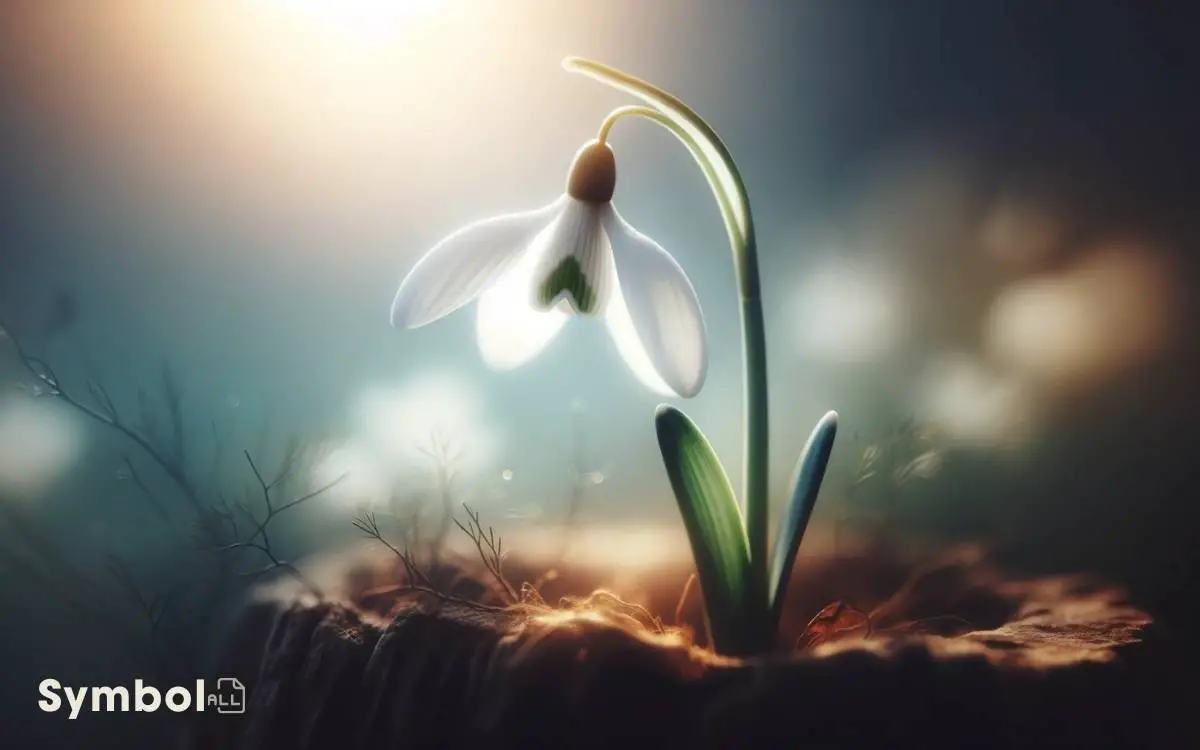What Does Snowdrop Flower Symbolize? Innocence!
You’ll discover the snowdrop, Galanthus, carries profound ecological and symbolic significance. Its pristine white petals symbolize innocence and a fresh start, reflecting its ability to thrive in the frosty embrace of early spring.
Beyond beauty, Galanthus features remarkable adaptations like galanthine alkaloids for breaking down leaf litter and thermogenesis for heat generation, demonstrating resilience and purity amidst adversity.
It serves as an early nectar source for pollinators, marking a renewal of life and resilience against the cold.
Such characteristics not only symbolize overcoming challenges but also enhance biodiversity, playing a crucial role in ecosystem health. Exploring further reveals deeper connections with this resilient flora.

Key Takeaways
The Essence of Hope
As a herald of spring, the snowdrop embodies hope, signifying the pivotal role of life amidst the harsh winter landscape.
You’ll find these delicate blooms often breaking through frost-covered soil, a phenomenon facilitated by their hardened leaf tips, scientifically termed as ‘apical meristems.’
These specialized structures enable the snowdrop to pierce through frozen terrain, making it one of the first plants to signal the end of winter’s grip.
Additionally, snowdrops engage in a symbiotic relationship with certain fungi, a process known as mycorrhiza, which enhances their nutrient uptake in the sparse, cold conditions.
This ecological strategy not only underscores their symbolic representation of hope but also highlights their essential role in the early spring ecosystem, pioneering vegetation reawakening.
Purity and Innocence
In the domain of botany, the snowdrop (Genus Galanthus) embodies purity and innocence through its stark white petals, a color often associated with these virtues in the plant kingdom.
You’ll find that its symbolic significance is deeply rooted in cultural associations, varying from tales of rebirth in Eastern Europe to signs of impending spring in Western folklore.
This plant’s ecological role, thriving in cold, early spring environments, further reinforces its emblematic representation of a fresh start and unblemished beginnings.
Symbolic Significance
Snowdrop flowers symbolize purity and innocence, reflecting their pristine white petals that emerge even in the harshest winter conditions.
These resilient blooms, scientifically known as Galanthus, offer more than just visual appeal; they serve as harbingers of spring, indicating the renewal of life.
- Galanthine Alkaloids: Unique compounds in snowdrops, instrumental in breaking down leaf litter, facilitating early spring growth.
- Pollination Strategy: Adapted to cold climates, snowdrops rely on early-emerging pollinators, emphasizing their ecological role in sustaining biodiversity.
- Snow Melt Adaptation: Their ability to penetrate frozen soil and snow exemplifies their purity and resilience.
- Thermogenesis: Snowdrops exhibit a rare trait of generating heat, which aids in melting surrounding snow, a symbol of their perseverance and innocence.
Cultural Associations
Throughout history, diverse cultures have embraced snowdrop flowers as symbols of purity and innocence, attributing to them a range of folklore and traditions that highlight their ecological significance and resilient beauty.
You’ll find that in the midst of winter’s harshness, Galanthus nivalis emerges, its pristine white petals defying the cold, embodying a symbol for purity. This botanical phenomenon isn’t merely aesthetic; it’s a validation to the snowdrop’s adaptive strategies.
The flower’s ability to penetrate the frozen ground is facilitated by a specialized leaf tip, or ’emergence tip,’ which contains antifreeze proteins. These proteins prevent cell damage in sub-zero temperatures, ensuring the snowdrop’s survival and subsequent bloom.
This resilience, coupled with its ethereal appearance, cements the snowdrop’s association with innocence across various cultures, mirroring life’s persistence amidst adversity.
A Symbol of Renewal
Emerging through the cold, barren ground of late winter, snowdrops symbolize the awakening of nature and herald the arrival of spring’s renewal.
- Galanthus nivalis: Often the first to bloom, snowdrops play a pivotal role in nectar provision for early pollinators.
- Phenological indicators: Their emergence is a reliable indicator of seasonal shift, crucial for ecological forecasting.
- Genetic resilience: Adapted to cold climates, snowdrops exhibit remarkable hardiness, underlining nature’s capacity for regeneration.
- Soil health: Snowdrop proliferation enhances soil structure and fertility, promoting a rich, biodiverse ecosystem.
You’re witnessing not just a floral spectacle but a sophisticated ecological event. Snowdrops don’t merely announce spring; they’re foundational to the seasonal recalibration of ecosystems, embodying the essence of renewal in the natural world.
Overcoming Adversity
In the face of harsh winter conditions, snowdrops exhibit an extraordinary capacity for survival, thriving in environments where other species may falter.
These resilient blooms possess a unique thermogenesis ability, generating heat to melt surrounding snow and ice, thereby facilitating their emergence.
Their foliage, endowed with antifreeze proteins, prevents cellular damage at sub-zero temperatures. This biological adaptation guarantees their survival through the freezing winter months, making them symbols of strength and perseverance.
You’ll find that their delicate appearance belies an underlying robustness, an evolutionary marvel that allows them to not just endure but flourish amidst adversity.
Snowdrops don’t merely survive; they demonstrate a remarkable resilience, embodying the essence of overcoming adversity in the natural world.
Harbinger of Spring
As you observe the snowdrop, Galanthus nivalis, its early emergence from the frosty ground serves as a crucial ecological indicator, signifying the onset of spring.
This plant’s ability to bloom while snow still blankets the earth positions it as spring’s first messenger, initiating a cascade of floral awakening.
Its presence not only symbolizes renewal but also plays an essential role in the ecosystem, supporting early pollinators and marking a pivotal moment in the seasonal cycle.
Early Bloom Significance
With their early bloom, snowdrop flowers signal the arrival of spring by breaking through the frosty soil. These delicate perennials possess an incredible resilience, emerging even when snow blankets the ground.
Their presence isn’t merely a visual delight but also serves as an essential ecological cue, indicating a shift in seasonal cycles.
- Galanthus nivalis, the botanical name for snowdrops, translates to ‘milk flower of the snow,’ highlighting their pristine white appearance against the winter backdrop.
- Snowdrops utilize a process called thermogenesis, generating heat to melt surrounding snow, facilitating their early emergence.
- Their blooming period stimulates the activity of pollinators, which are scarce in early spring, playing a crucial role in the ecosystem.
- They act as a bioindicator, reflecting the health and changes in environmental conditions.
Springs First Messenger
Snowdrops emerge as the first messengers of spring, heralding the end of winter with their resilient blooms that play an important role in the ecological shift.
These delicate flowers not only signify the forthcoming warmth but also activate a sequence of environmental changes. Their early appearance under the snow cover provides essential nectar sources for pollinators emerging from hibernation.
| Aspect | Detail | Ecological Impact |
|---|---|---|
| Pollination | Early nectar source for bees | Enhances pollinator activity |
| Temperature | Thrive in cold, signal warming trends | Indicate climatic alterations |
| Biodiversity | Support early-spring ecosystems | Promote species diversity and interdependence |
You’ll find these flowers initiate a cascade of biological interactions, fostering a vibrant ecosystem even in the tail end of frosty conditions.
Symbol of Renewal
Many consider the emergence of snowdrop flowers a potent symbol of renewal, marking the shift from the cold, barren winter to the promise of spring’s warmth and liveliness.
- Galanthus nivalis, commonly known as the snowdrop, is a geophyte, utilizing underground storage organs to survive winter.
- These flowers exhibit thermogenesis, producing heat to melt surrounding snow, facilitating early spring growth.
- Snowdrops engage in mutualistic relationships with pollinators, signaling the reawakening of ecological interactions post-winter.
- The presence of snowdrops indicates soil health and microclimate stabilization, necessary for the resurgence of diverse flora and fauna.
Understanding the ecological significance of snowdrops enriches your appreciation for these harbingers of spring, highlighting their role in ecological renewal and biodiversity.
Connection to the Divine
Throughout history, humans have looked to snowdrops as harbingers of spiritual renewal, symbolizing a bridge between earthly existence and the divine domain.
These delicate blooms, scientifically known as Galanthus, emerge in late winter, often through snow, representing resilience and purity.
Their pristine white petals aren’t merely aesthetic; they’re an adaptive feature for thermoregulation, enabling the plant to attract early pollinators and symbolize hope amidst adversity. This remarkable adaptation allows the plant to thrive in cooler climates, ensuring its survival and prominence in diverse ecosystems. Often referred to as a flower that symbolizes the moon, its luminous presence in the night evokes a sense of calm and mystery. Its resilience and understated elegance make it a perennial reminder of nature’s delicate balance and quiet strength.
In ecosystems, snowdrops play a critical role in signaling the awakening of spring, mirroring spiritual awakening and enlightenment.
This botanical phenomenon underscores a profound connection to the divine, illustrating nature’s intricate design and its capability to inspire transcendence, guiding individuals towards a deeper, spiritual understanding of their place within the natural world.
Mourning and Remembrance
In the domain of flora, the snowdrop flower serves as a poignant emblem for mourning and remembrance, bridging the gap between personal loss and the cyclical nature of life.
As you explore its symbolism, it’s crucial to note the following aspects:
- Galanthus nivalis, the botanical name for snowdrop, translates to ‘milk flower of the snow,’ reflecting its pure appearance amidst winter’s harshness.
- These blooms emerge in late winter, often pushing through snow, symbolizing resilience in the face of adversity.
- The snowdrop’s ephemeral nature, blooming briefly before disappearing, mirrors the fragile and temporary nature of life itself.
- Victorians extensively used snowdrops in funeral arrangements and to adorn graves, underscoring their association with mourning and eternal remembrance.
New Beginnings
As you observe the snowdrop, Galanthus spp., piercing through the last snow, it heralds spring’s first bloom, signaling an ecological shift from dormancy to awakening.
This emergence embodies renewal and rebirth, as it initiates a sequence of floral progression, revitalizing ecosystems with new life.
The resilient bloom offers hope after darkness, illustrating nature’s cyclical resilience and the promise of regeneration.
Springs First Bloom
The snowdrop flower, marking the onset of spring, symbolizes new beginnings with its resilient emergence through the last of winter’s snow. This petite, yet formidable plant, exhibits a remarkable adaptation to cold climates.
Its ability to penetrate the frosty ground is facilitated by a specialized leaf tip, known as an apical meristem, which contains antifreeze-like compounds.
- Geophyte Adaptation: Utilizes underground storage organs to survive winter.
- Photoperiodism: Senses increasing daylight, triggering flowering.
- Thermogenesis: Generates heat to melt surrounding snow.
- Ecological Role: Early pollen source for pollinators.
Understanding the snowdrop’s lifecycle and adaptations offers insight into the intricate balance of ecosystems and underscores the significance of preserving biodiversity for the health of our planet.
Renewal and Rebirth
Symbolizing renewal and rebirth, the snowdrop flower embodies the essence of new beginnings as it bravely pierces through the last remnants of winter snow, heralding the arrival of spring with its delicate bloom.
This phenomenon, known as vernalization, requires the cold embrace of winter to trigger its germination process, demonstrating a remarkable adaptation to its environment.
The snowdrop’s emergence is a critical signal within the ecosystem, indicating a shift from dormancy to active growth. Its presence supports the revitalization of flora and fauna, serving as an early nectar source for pollinators.
Therefore, the snowdrop doesn’t just symbolize, but actively participates in the cycle of renewal, playing a pivotal role in the ecological succession that rejuvenates the landscape after the cold, barren months.
Hope After Darkness
Building on its role in signaling the onset of spring, the snowdrop also embodies hope after darkness, marking not just a physical but a metaphorical thaw where life’s possibilities unfold anew.
This delicate flora emerges from the frost-hardened soil, pioneering the rebirth of the ecosystem.
As you explore its significance, consider these aspects:
- Geophyte Adaptations: Snowdrops utilize underground storage organs to survive winter’s harshness.
- Phenological Cues: They respond to slight temperature increments, heralding spring’s approach.
- Pollinator Interactions: Early blooming attracts scarce winter pollinators, essential for ecosystem dynamics.
- Symbolic Resilience: Their presence signifies endurance and the capability to flourish post-adversity.
Understanding snowdrops in this light, you grasp their pivotal role in both natural and symbolic domains, embodying the shift from darkness to renewed vitality.
The Cycle of Life
In ecosystems, snowdrop flowers emerge as harbingers of spring, signaling a rebirth in the cycle of life. These resilient plants thrive under harsh conditions, often piercing through snow to bloom.
Their presence marks a significant phase in ecological succession, preparing the environment for subsequent floral generations.
Snowdrops engage in a symbiotic relationship with pollinators, ensuring cross-pollination. This process is crucial for genetic diversity, contributing to the robustness of ecosystems.
Additionally, their early blooming serves as a cue for the awakening of other species from winter dormancy, fostering a vibrant biodiverse habitat.
As they decompose, snowdrops enrich the soil with nutrients, facilitating the growth of future flora. Hence, they play a pivotal role in the perpetuation and health of their ecosystems.
A Sign of Consolation
Beyond their ecological role, snowdrops offer a profound sense of solace to many, embodying hope in the bleakest winter days.
These resilient perennials emerge through frozen soil, often while snow still blankets the ground, serving as a botanical metaphor for endurance and rebirth.
- Thermogenesis: Snowdrops engage in this process to melt the surrounding snow, symbolizing the melting away of sorrows.
- Early Pollinators: They provide nectar for the first pollinators, signifying the interconnectedness of life and hope.
- Adaptability: Their ability to thrive in cold temperatures represents resilience in the face of adversity.
- Purity and Renewal: The white petals reflect purity and the promise of new beginnings, offering comfort to those in mourning or despair.
Snowdrops’ emergence is a natural consolation, reminding us of the cycle of life and the persistence of hope.
Bridging Worlds
Snowdrops serve as an important link between the cold grasp of winter and the burgeoning life of spring, symbolizing the smooth shift across seasons. These resilient plants emerge through frozen soil, often piercing through snow, to herald the upcoming warmth.
Their presence isn’t merely aesthetic but serves an ecological purpose, initiating the phenological calendar. By blooming early, snowdrops provide essential nectar sources for pollinators awakening from winter dormancy.
Their cyclical life cycle, from dormancy to bloom, mirrors the ecological shift zones, acting as bioindicators for environmental changes.
This early flowering is a survival strategy, allowing them to complete their life cycle before the canopy closes, ensuring sunlight penetrates to the forest floor. Snowdrops embody the change, facilitating ecological processes that bridge the stark worlds of winter and spring.
Eternal Love
As symbols of eternal love, snowdrops exemplify nature’s resilience, thriving in the harshest conditions to bloom anew each year. These delicate flowers, emerging through snow, symbolize the enduring strength and purity of love that persists despite adversity.
The snowdrop’s botanical characteristics further underscore its association with eternal love:
- Galanthus nivalis: The genus name translates from Greek as ‘milk flower,’ reflecting its pure white appearance.
- Vernal Emergence: Snowdrops bloom in late winter or early spring, heralding the coming of warmer days.
- Geophyte Adaptations: Possessing specialized underground storage organs, snowdrops can survive sub-zero temperatures.
- Clonal Propagation: Through bulb division, they guarantee their genetic legacy continues, mirroring the enduring nature of love across generations.
The Language of Flowers
Exploring the language of flowers reveals that each species communicates specific sentiments, with snowdrops symbolizing hope and renewal amidst the winter’s chill.
This intricate system, known as floriography, enables the conveyance of complex emotions and messages through botanical specimens.
Snowdrops, or *Galanthus nivalis*, emerge as harbingers of spring, often breaking through frozen ground. This phenological cue signifies resilience and the inevitable return of warmth and abundance.
Their pristine white blossoms, dangling from a singular, slender stalk, embody purity and the fresh start that accompanies the vernal equinox.
In the ecological context, snowdrops play a critical role in early-season pollination networks, supporting insects emerging from hibernation.
Understanding these connections enriches our appreciation of snowdrops’ symbolic meanings, intertwining botanical science with cultural narratives.
Conclusion
In the delicate dance of ecology, the snowdrop emerges as a resilient harbinger, signaling the rebirth of flora. Your understanding of its symbolism weaves through the fabric of nature’s narrative, embodying purity, hope, and the eternal cycle of renewal.
Amidst the chill of adversity, it stands as a confirmation of the enduring essence of spring’s promise.
Therefore, in the language of flowers, the snowdrop whispers of life’s perpetual bloom, echoing a symphony of consolation and love across the silent, awakening earth.






